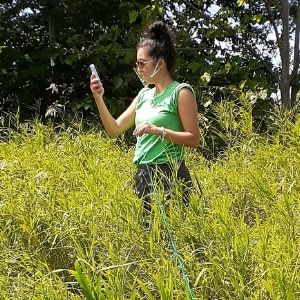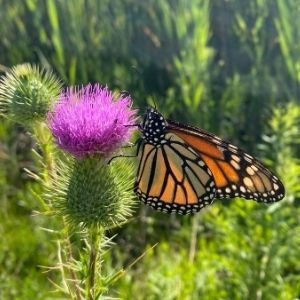Last month, Brian and I spent three sunny days counting how many native species and invasive non-natives could be found on four locations across Richmond Hill and King. These sites, composed of public lands and/or parkland, will be planted with native trees and shrubs by LEAF staff and volunteers this fall season.
Our goal at each site was to determine the species diversity and abundance, and use the data collected as a baseline to look at the progress of each site after it’s been naturalized by a LEAF planting event. We conducted the assessments by creating up to eight, 50 m2 circular plots in each site. One person took the end of a rope and stayed stationary while the other person walked in a circle. 
Doing this work, I gained much experience and knowledge on collecting data to monitor plant species in these naturalized areas. Not only that, I also created wonderful new memories of my time out in the field that I will cherish for years to come.
It was amazing to see all the sites that will be transformed by planting trees and shrubs. Once I got out of the car and stepped onto each site, I felt so serene just being there; hearing the birds chirp or kids play in the park. Each site has its own uniqueness to it, some had steep terrain, and others were flat-surfaced, while others were filled with many trees and shrubs.

Before going to the planting locations, I pictured my week going smoothly while assessing the areas. But, each day, after completing the assessments, I went home with more leaf litter, burdock seeds and needles from thistles on me to last a lifetime! That week, the sun was scorching hot and very humid. I made sure to bring a huge water bottle to keep hydrated but, when beautiful little clouds covered the sun and the chilly winds came in, I appreciated that moment all the same.
Sometimes, we may think that one small community or one person cannot make a difference in helping the environment (or for any other pressing issues going around the world), but I don’t believe that’s true. After visiting all these beautiful sites and working for LEAF, I feel that we can make a huge difference, whether as an individual or as a community, in changing our urban forests so that they are more sustainable and healthy.
This blog was written by Annabella Aoshana, the Stewardship Assistant at LEAF
Our community planting and stewardship events are supported by Ontario Power Generation, the Regional Municipality of York, the City of Richmond Hill and Grandtrees Climate Solutions.
